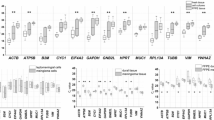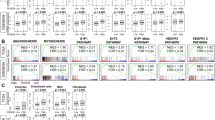Abstract
Introduction
Real time RT-PCR is a widely used technique to evaluate and confirm gene expression data obtained in different cell systems and experimental conditions. However, there are many conflicting reports about the same gene or sets of gene expression. A common method is to report the interest gene expression relative to an internal control, usually a housekeeping gene (HKG), which should be constant in cells independently of experimental conditions.
Materials and Methods
In this study, the expression stability of ten HKGs was considered in parallel in two cell systems (endothelial and osteosarcoma cells): beta actin (ACTB), glyceraldehyde-3-phosphate dehydrogenase (GAPDH), TATA box binding protein (TBP), hypoxanthine phosphoribosyl-transferase 1 (HPRT1), Cyclophilin A (PPIA), beta-2-microglobulin (B2M), glucuronidase beta (GUSB), eukaryotic translation elongation factor 1 alpha1 (EEF1A1), transferrin receptor (TFRC), ribosomal protein S18 (RPS18). In order to study the stability of candidate reference genes, data have been also analyzed by several algorithms (geNorm, NormFinder, BestKeeper and delta-Ct method).
Results and Conclusions
The overall analysis obtained by the comprehensive ranking showed that RPS18 and PPIA are appropriate internal reference genes for tumor neovascularization studies where it is necessary to analyze both systems at the same time.


Similar content being viewed by others
References
Reis-Filho JS, Pusztai L (2011) Gene expression profiling in breast cancer: classification, prognostication, and prediction. Lancet 378:1812–1823
Radonić A, Thulke S, Mackay IM, Landt O, Siegert W, Nitsche A (2004) Guideline to reference gene selection for quantitative real-time PCR. Biochem Biophys Res Commun 313:856–862
Bustin SA (2000) Absolute quantification of mRNA using real-time reverse transcription polymerase chain reaction assays. J Mol Endocrinol 25:169–193
Kaltenboeck B, Wang C (2005) Advances in real-time PCR: application to clinical laboratory diagnostics. Adv Clin Chem 40:219–259
Iinuma H, Okinaga K, Egami H, Mimori K, Hayashi N, Nishida K, Adachi M, Mori M, Sasako M (2006) Usefulness and clinical significance of quantitative real-time RT-PCR to detect isolated tumor cells in the peripheral blood and tumor drainage blood of patients with colorectal cancer. Int J Oncol 28:297–306
Dheda K, Huggett JF, Chang JS, Kim LU, Bustin SA, Johnson MA, Rook GA, Zumla A (2005) The implications of using an inappropriate reference gene for real-time reverse transcription PCR data normalization. Anal Biochem 344:141–143
Schmittgen TD, Zakrajsek BA (2000) Effect of experimental treatment on housekeeping gene expression: validation by real-time, quantitative RT-PCR. J Biochem Biophys Meth 46:69–81
de Kok JB, Roelofs RW, Giesendorf BA, Pennings JL, Waas ET, Feuth T, Swinkels DW, Span PN (2005) Normalization of gene expression measurements in tumor tissues: comparison of 13 endogenous control genes. Lab Invest 85:154–159
Cicinnati VR, Shen Q, Sotiropoulos GC, Radtke A, Gerken G, Beckebaum S (2008) Validation of putative reference genes for gene expression studies in human hepatocellular carcinoma using real-time quantitative RT-PCR. BMC Cancer 8:350
Goidin D, Mamessier A, Staquet MJ, Schmitt D, Berthier-Vergnes O (2001) Ribosomal 18S RNA prevails over glyceraldehyde-3-phosphate dehydrogenase and beta-actin genes as internal standard for quantitative comparison of mRNA levels in invasive and noninvasive human melanoma cell subpopulations. Anal Biochem 295:17–21
Caradec J, Sirab N, Keumeugni C, Moutereau S, Chimingqi M, Matar C, Revaud D, Bah M, Manivet P, Conti M, Loric S (2010) ‘Desperate house genes’: the dramatic example of hypoxia. Br J Cancer 102:1037–1043
Eisenberg E, Levanon EY (2003) Human housekeeping genes are compact. Trends Genet 19:362–365
Shaw GT, Shih ES, Chen CH, Hwang MJ (2011) Preservation of ranking order in the expression of human housekeeping genes. PLoS One 6:e29314
Zhang L, Li WH (2004) Mammalian housekeeping genes evolve more slowly than tissue-specific genes. Mol Biol Evol 21:236–239
Napoli C, Hayashi T, Cacciatore F, Casamassimi A, Casini C, Al-Omran M, Ignarro LJ (2011) Endothelial progenitor cells as therapeutic agents in the microcirculation: an update. Atherosclerosis 215:9–22
Rienzo M, Nagel J, Casamassimi A, Giovane A, Dietzel S, Napoli C (2010) Mediator subunits: gene expression pattern, a novel transcript identification and nuclear localization in human endothelial progenitor cells. Biochim Biophys Acta 1799:487–495
Rubie C, Kempf K, Hans J, Su T, Tilton B, Georg T, Brittner B, Ludwig B, Schilling M (2005) Housekeeping gene variability in normal and cancerous colorectal, pancreatic, esophageal, gastric and hepatic tissues. Mol Cell Probes 19:101–109
de Nigris F, Rossiello R, Schiano C, Arra C, Williams-Ignarro S, Barbieri A, Lanza A, Balestrieri A, Giuliano MT, Ignarro LJ, Napoli C (2008) Deletion of Yin Yang 1 protein in osteosarcoma cells on cell invasion and CXCR4/angiogenesis and metastasis. Cancer Res 68:1797–1808
Schiano C, Grimaldi V, Casamassimi A, Infante T, Esposito A, Giovane A, Napoli C (2012) Different expression of CD146 in human normal and osteosarcoma cell lines. Med Oncol (Epub ahead of print)
Costa V, Sommese L, Casamassimi A, Colicchio R, Angelini C, Marchesano V, Milone L, Farzati B, Giovane A, Fiorito C, Rienzo M, Picardi M, Avallone B, Marco Corsi M, Sarubbi B, Calabrò R, Salvatore P, Ciccodicola A, Napoli C (2010) Impairment of circulating endothelial progenitors in Down syndrome. BMC Med Genomics 3:40
Vandesompele J, De Preter K, Pattyn F, Poppe B, Van Roy N, De Paepe A, Speleman F (2002) Accurate normalization of real-time quantitative RT-PCR data by geometric averaging of multiple internal control genes. Genome biology 3(7):RESEARCH0034
Andersen CL, Jensen JL, Orntoft TF (2004) Normalization of real-time quantitative reverse transcription-PCR data: a model-based variance estimation approach to identify genes suited for normalization, applied to bladder and colon cancer data sets. Cancer Res 64:5245–5250
Pfaffl MW, Tichopad A, Prgomet C, Neuvians TP (2004) Determination of stable housekeeping genes, differentially regulated target genes and sample integrity: BestKeeper–Excel-based tool using pair-wise correlations. Biotechnol Lett 26:509–515
Silver N, Best S, Jiang J, Thein SL (2006) Selection of housekeeping genes for gene expression studies in human reticulocytes using real-time PCR. BMC Mol Biol 7:33
Xie F, Sun G, Stiller JW, Zhang B (2011) Genome-wide functional analysis of the cotton transcriptome by creating an integrated EST database. PLoS One 6(11):e26980
de Nigris F, Crudele V, Giovane A, Casamassimi A, Giordano A, Garban HJ, Cacciatore F, Pentimalli F, Marquez-Garban DC, Petrillo A, Cito L, Sommese L, Fiore A, Petrillo M, Siani A, Barbieri A, Arra C, Rengo F, Hayashi T, Al-Omran M, Ignarro LJ, Napoli C (2010) CXCR4/YY1 inhibition impairs VEGF network and angiogenesis during malignancy. Proc Natl Acad Sci 107:14484–14489
Tan SC, Carr CA, Yeoh KK, Schofield CJ, Davies KE, Clarke K (2011) Identification of valid housekeeping genes for quantitative RT-PCR analysis of cardiosphere-derived cells preconditioned under hypoxia or with prolyl-4-hydroxylase inhibitors. Mol Biol Rep 39(4):4857–4867
Caradec J, Sirab N, Revaud D, Keumeugni C, Loric S (2010) Is GAPDH a relevant housekeeping gene for normalisation in colorectal cancer experiments? Br J Cancer 103:1475–1476
Colell A, Green DR, Ricci JE (2009) Novel roles for GAPDH in cell death and carcinogenesis. Cell Death Differ 16:1573–1581
Zhang Y, Chen D, Smith MA, Zhang B, Pan X (2012) Selection of reliable reference genes in Caenorhabditis elegans for analysis of nanotoxicity. PLoS One 7(3):e31849
Conflict of interest
None.
Author information
Authors and Affiliations
Corresponding author
Additional information
M. Rienzo and C. Schiano contributed equally to this study.
Rights and permissions
About this article
Cite this article
Rienzo, M., Schiano, C., Casamassimi, A. et al. Identification of valid reference housekeeping genes for gene expression analysis in tumor neovascularization studies. Clin Transl Oncol 15, 211–218 (2013). https://doi.org/10.1007/s12094-012-0904-1
Received:
Accepted:
Published:
Issue Date:
DOI: https://doi.org/10.1007/s12094-012-0904-1




